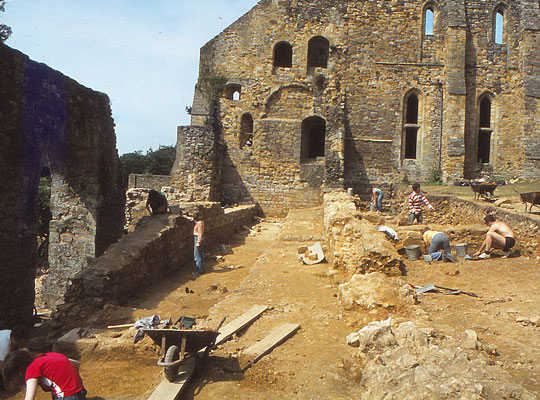Research on Battle Abbey and Battlefield
The profound consequences for England of the Battle of Hastings have ensured that the personalities involved and the rival armies have been and continue to be closely scrutinised and discussed. The topography of the battlefield, and even its precise location, similarly attract research and debate.

Current State of Research
The huge amount of literature on the Battle of Hastings reflects how the events surrounding 1066 have long attracted historians. Each generation has looked afresh at the evidence, often approaching it from different perspectives and with different emphases.
Anglo-Norman Studies, the proceedings of the annual Battle Conference of the same name (see Sources for Battle Abbey and Battlefield), are witness to this continuing interest and a good starting point for understanding the breadth of recent and current research.
While the circumstances of the abbey’s founding and establishment were highly unusual, its subsequent history largely mirrored that of similar rich religious houses. Modern research is being aided by the survival (and publication) of many of the abbey’s records.
The post-Suppression history of the abbey and its estate is similarly helped by the survival of records from this period. Publications by the Duchess of Cleveland[1] and Roy Pryce[2]especially provide much information on this aspect of the site.
Excavations
Archaeological excavations in 1978–80 on the site of the chapter house and the monastic latrine revealed significant remains of both buildings and a wealth of archaeological finds, many of which are now displayed in the gatehouse museum.[3]
Building recording and limited archaeological investigations associated with ongoing conservation work on the monastic and later buildings are adding to our knowledge. English Heritage hopes to undertake further archaeological work within the former abbey park to see whether evidence from the battle survives below ground in this area.
Location of the Battlefield
Until recently Battle Abbey was regarded as being at least the very probable location of the Battle of Hastings. Two recently published books, however, by Nick Austin[4] and John Grehan and Martin Mace,[5]have claimed that the battle occurred elsewhere.
Austin locates the battlefield about 3 miles south of Battle at the village of Crowhurst, while Grehan and Mace suggest Caldbec Hill, about 1 mile north of the abbey. Both theses claim that the topography of the chosen site better matches the terrain described in the primary sources and that the Chronicle of Battle Abbey was the earliest source to identify the abbey site as the location of the battle.
In response, Roy Porter [6] has argued that the Chronicle stands as the summation of a tradition that locates the abbey on the actual battlefield, attested by several other documentary sources that allow this tradition to be traced back to within living memory of 1066.
In 2013 landscape analysis and survey undertaken by archaeologists from the Time Team television series suggested that a focus of the fighting was about 200 metres east of the later abbey church. They interpreted this evidence as proof of a new site for the battle, although the area was already understood by historians to have been part of the battlefield.[7]
Instead, this work can be seen as adding to current understanding of the physical constraints within which the opposing armies met in 1066.[8]
- Read more on the debate about the battlefield’s location
Gaps in Current Knowledge
There remains considerable scope for further research, including (in no particular order) in the following areas:
- the evolution of the landscape of the battlefield from the 11th century onwards
- the likely extent of the battlefield and its topography at the time of the battle
- memory and commemoration of the battle at the abbey
- the religious life of the monks and how this evolved over the Middle Ages
- the economic and estate history of the abbey, including its links with its outlying estates, the town and the local families who traded with it, and whose sons became monks or abbey officials. Further research in the abbey manuscripts may shed light on these areas
- the function of the intra-mural passageways recently discovered in the gatehouse
- the post-Suppression evolution of the former abbey buildings
- the location of the recusant chapel of Viscountess Montague
- the development of the gardens under the Websters and Clevelands in the 18th and 19th centuries
- the evolution of the abbey’s outer court and its associated buildings, including post-Suppression changes that have led to its present appearance.
READ MORE ABOUT BATTLE ABBEY AND 1066 BATTLEFIELD
Footnotes
1. CLW Cleveland, Duchess of Cleveland, History of Battle Abbey (London, 1877).
2. R Pryce, Battle Abbey and the Websters: Two Hundred Years of Ambition, Profligacy and Misfortune (Heathfield, 2005).
3. JN Hare, Battle Abbey: The Eastern Range and Excavations of 1978–1980 (London, 1985).
4. N Austin, Secrets of the Norman Invasion (Crowhurst, 2010).
5. J Grehan and M Mace, The Battle of Hastings 1066: The Uncomfortable Truth (Barnsley, 2012).
6. R Porter, ‘“On the very spot”: in defence of Battle’, English Heritage Historical Review, 7 (2012), 4–17 (subscription required; accessed 2 June 2014).
7. See, for example, JH Ramsay, The Foundations of England (Oxford, 1898) and MK Lawson, The Battle of Hastings 1066 (Stroud, 2007).
8. R Porter, ‘A new site for the Battle of Hastings?’, Heritage Calling [English Heritage blog], 2 Dec 2013.